Relief


Relief

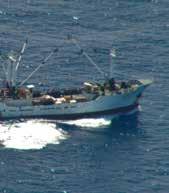

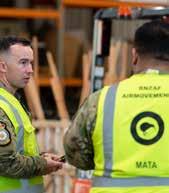
OUR MISSION
The RNZAF will provide New Zealand with relevant, responsive and effective Air Power to meet its security interests.
OUR VISION
An agile and adaptive Air Force with the versatility essential for NZDF operations.
PHOTOGRAPHER: PO Chris Weissenborn

Published by Defence Public Affairs HQ NZ Defence Force Wellington, New Zealand
Editor Rebecca Quilliam Email: airforcenews@nzdf.mil.nz
Design and Layout Defence Public Affairs
Printed by Bluestar Private Bag 39996, Wellington
Distribution Email: airforcenews@nzdf.mil.nz
Editorial contributions and ideas are welcomed. They can be emailed directly to the Editor and do not need to be forwarded through normal command chains.
Contributions need to include
• writer’s name, rank and unit
• photos provided separate from the text – at least 300dpi.
Air Force News will hold the copyright for submitted articles or photographs it publishes. Articles and photographs published in Air Force News cannot be published elsewhere without permission.

“Whether pre-planned or in emergency situations we will be ready to provide this support whenever the Government needs it and it is my highest priority to ensure that we as a force are ready and able to do this safely.”
The middle of the year gives us the chance to reflect upon our achievements to date while looking forward to the work ahead of us for the rest of the year.
So far 2024 has been a highly successful year for the RNZAF, with April and May seeing all Force Element aircraft types and supporting staff from across the service deployed simultaneously on multiple operations across the region.
The tempo has not let up and this month’s Air Force News highlights exactly what we are here to do as a force – to provide the Government response options to both support New Zealanders and our neighbours or to demonstrate our support to uphold the international rulesbased order.
Last month we delivered this through the successful completion of Op Whio, the first operational deployment of the P-8A Poseidon to enforce UN sanctions against North Korea. We also delivered humanitarian aid via our C-130s to our Papua New Guinean friends following a devastating landslide – the second time we have provided aid there in two months after the earthquake in March.
We helped to get New Zealanders back from New Caledonia following the cancellation of civilian flights, we deployed our maritime helicopters along with Royal New Zealand Navy major fleet units on deployment into the Indo-Pacific, and at all times remained ready to respond to national contingency operations both at home and abroad.
This is why we are here. This is why we joined. This is who we are. We must never take our eyes off this goal as maintaining this ability takes training, planning and a clear focus of what is important.
As we look ahead to the next few months the tempo will continue to be high as we focus on preparedness, sending our teams away on Exercise Rimpac, in Hawaii, the largest naval exercise on the planet, which allows us to interoperate with partners in the maritime domain.
On Exercise Pitch Black in Australia we will ensure our combat support capabilities hone their skills. And then looking ahead to Ex Bersama Lima where we demonstrate our commitment to the Five Power Defence Arrangements; before being ready to support the Commonwealth Heads of Government meeting in Samoa with personnel and aircraft from a variety of Force Elements and supporting units.
All this will be set against the backdrop of the arrival of the C-130J and full operational release of the P-8A.
These activities are all critical to have our teams ready to meet the challenges of 2024 and beyond and although there is a lot of work ahead of us, I know we have the right team to deliver.

Ship-to-ship transfers, suspected to be in violation of United Nations Security Council (UNSC) resolutions, which impose sanctions against North Korea, have been observed and reported during New Zealand Defence Force maritime patrols this year.
An Air Force P-8A Poseidon flew 11 missions to detect and deter evasions of UNSC resolutions, during April and May.
This was the NZDF’s sixth deployment since 2018 of a maritime patrol aircraft and specialist personnel for this purpose, and the first overseas operational deployment for the P-8A Poseidon.
North Korea continues to launch ballistic missiles in violation of UNSC resolutions. The sanctions are intended to persuade North Korea to denuclearise and abandon its ballistic missile weapons capabilities. Defence Force patrols are conducted in support of the UNSC Resolution Enforcement Coordination Centre, which coordinates efforts by Pacific Security Maritime Exchange contributing nations –including New Zealand.
No. 5 Squadron Commanding Officer Wing Commander (WGCDR) Mark Whiteside was the detachment commander for the deployment. Although patrols were conducted over international waters, being in the vicinity of some of the busiest commercial shipping lanes in the world added complexity to the operations, he said.
“Those seeking to evade the UNSC sanctions adopt various tactics to try and hide what they are doing.
“Our personnel worked well together, acting on information about vessels of interest, identifying potential sanctions evasions at sea, documenting and reporting these activities,” WGCDR Whiteside said.
“Vessels were observed conducting shipto-ship transfers, potentially of banned goods such as oil and coal - which are key enablers that allow North Korea to continue its weapons programme.”
After 11 missions and 88 flying hours, four ship-to-ship transfers and 30 vessels of interest were observed, while a further 33 vessels suspected of violating UNSCR sanctions were reported.
The Defence Force’s deployments, working alongside partners on enforcement operations, uphold the international rules-based system and contribute to regional stability and security.
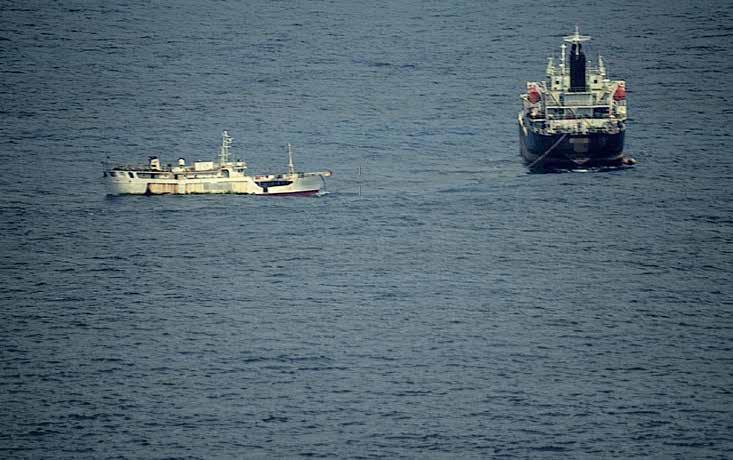
A P-8A Poseidon surveillance crew has clocked up about 9000 nautical miles monitoring fishing activities in the exclusive economic zones of the Cook Islands, Fiji, Tokelau, Tonga and Tuvalu.
Predominantly crewed by No. 5 Squadron Training Flight instructors and students, they were part of a multi-national contribution to the illegal, unregulated and unreported fishing monitoring Operation Tui Moana for the Forum Fisheries Agency (FFA).
Thirty-eight vessels - fishing vessels, merchant vessels and pleasure craft –were recorded by the Poseidon crew and reported to the FFA.
Air Component Commander Air Commodore Andy Scott says it was a great opportunity to have the students working on the Poseidon in a real-world operation.
“Airborne surveillance and reconnaissance for maritime security, fisheries monitoring and search and rescue are key tasks for No. 5 Squadron, and the new P-8A provides even greater range and capabilities for these tasks,” he said.
“The flight instructors and students joined the operation as part of our training to ensure the squadron is at full strength in qualified aircrew.”
Nine FFA members (Australia, Cook Islands, Fiji, New Zealand, Niue, Samoa, Tokelau, Tonga and Tuvalu) participated in the operation alongside technology partners, assets and personnel from the Pacific Quadrilateral Defence Coordination Group (QUAD). That group is made up of Australia, France, New Zealand and the United States, in an area of about six million square kilometres.
They covered an area approximately the size of Australia.
The operation placed an emphasis on boarding activities, cooperative surveillance engagements amongst FFA members and the Pacific QUAD countries, and the use of remote sensing information to drive the intelligence-led operation.
There were more than 500 vessel contacts during the operation using air, surface and remote-sensing platforms, with 80 boardings carried out in port and at sea.
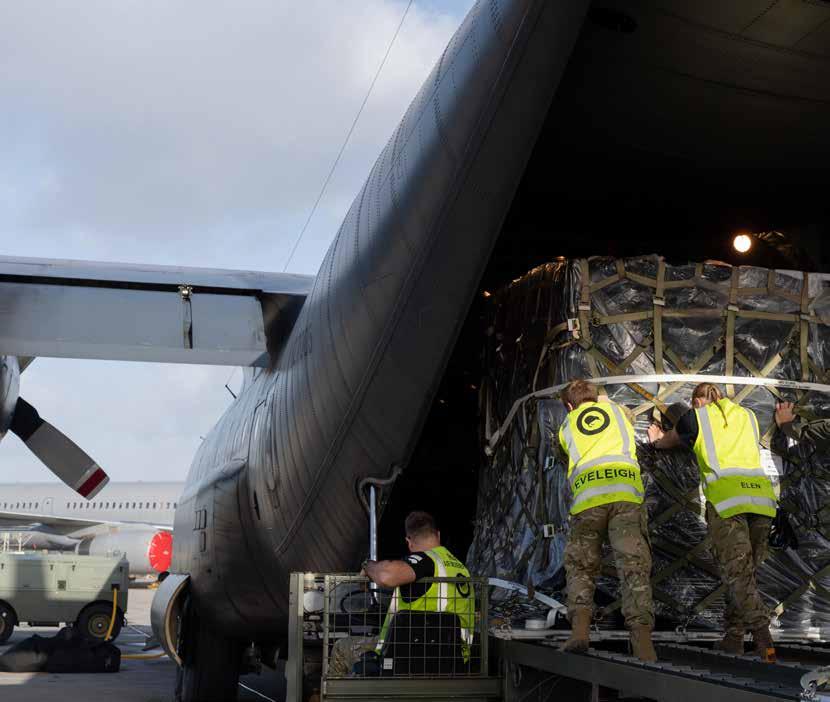
A C-130 Hercules aircraft has flown to Papua New Guinea carrying relief supplies for communities affected by the landslide that occurred in Enga province in late May.
According to the Papua New Guinea (PNG) National Disaster Centre it was estimated that more than 2000 people were buried under the slip. Relief supplies taken to the devastated area included tools, shelter and hygiene products from the Ministry of Foreign Affairs and Trade.
The support package, estimated about $1.5 million, included the flight with relief supplies; sending New Zealand technical expertise to assist in the areas of geo-hazards and emergency management; and financial assistance to provide humanitarian relief to affected areas.
The Hercules flew into PNG’s Wapenamanda Airport carrying about 48,000lbs of aid. It also transported the PNG National Disaster Centre (NDC) Director to Port Moresby.
Hercules pilot Flight Lieutenant (FLTLT) Connor Broughton said the mission was flown over a four-day period.
“We couldn’t see any damage from the slip because it was right in the middle of the mountain ranges, but the airport was only about 10km away from it. Helicopters were used to get the aid to the site.”
The high altitude of the area meant flying into PNG came with its own challenges, he said.
“We never really land on such high airfields – about 5500ft. It makes the performance of the aircraft more challenging, it’s also quite hot there, so there are those two factors.
“It was great to be able to use the airfields there, which we weren’t used to, and working with the Australians is always good.

“Once we got to PNG I found it incredible to see how much aid had been donated –it came from all around the world. It was quite cool to see.”
Before the humanitarian aid and disaster relief flight to PNG, FLTLT Broughton had been deployed to fly repatriation flights to New Caledonia, which was embroiled in civil unrest.
“We had a busy period at the time flying to both places. After New Caledonia I had a day off, then went to PNG. It was pretty much rescue after rescue.”
As the relief flights were leaving Joint Forces New Zealand Commander Rear Admiral James Gilmour said his thoughts reached out to those who were still searching for loved ones after the landslide in the Enga province.
“We will work with our Papua New Guinea neighbours to understand what it is they require and we stand ready to assist them if needed.”





In mid-May violent protests, leading to eight deaths, rocked New Caledonia forcing a state of emergency. Commercial flights to the popular destination were cancelled and hundreds of New Zealanders were left stranded on the French territory, prompting the New Zealand Government to direct Air Force aircraft to bring them home.

Over the period of a week, an Air Force C-130 Hercules and its crew flew 361 passengers from the South Pacific French territory to New Zealand on seven flights. The crews also repatriated 124 people from Auckland – who live in New Caledonia – back home.
On the aircraft’s arrival into Nouméa’s Magenta Airport passengers were escorted onto the tarmac by French military. Stations were set up for Ministry of Foreign Affairs and Trade authorisations as well as fitness-to-fly clearances.
Passengers were given screening forms for illnesses and other medical issues as well as any concerns around flying and if anyone needed ongoing support or care during the flight.
Air loadmaster Sergeant (SGT) Emma Porritt worked on three of the flights and said the mission was gratifying because of the tangible help they were able to offer people.
A small team of five personnel stayed at Nouméa to process the passengers. The airport had been secured by the French military and SGT Porritt said the deployment felt very safe.
Part of her role was briefing the passengers about what it was like to fly in a Hercules, which is quite different to civilian aircraft.
“We had blankets and snacks to get them through the three and a half hour flight back to Auckland. We had a medical team on board and everyone helped out with the comforts - including explaining the toilet.”
SGT Porritt said the passengers seemed happy to be able to leave for home.
“They hadn’t really had a holiday because the violence started about a week before we were able to get in – they had mostly just been stuck at a hotel, so were really grateful to be getting out and home. They didn’t even really mind the discomforts of the Hercules, and seemed to enjoy the experience.”

The crew also flew home some international passengers –20 Australians and 26 Americans – who were going to Auckland and then getting flights home from there.
“It was probably some of the most exciting flying that I’ve done. I’ve only been at No. 40 Squadron for the last two or three years. Doing something that directly helped people and you could see the impact that had, was quite rewarding,”
SGT Porritt said.
“We don’t often get to fly members of the public around – it’s usually either our military or international forces who are used to the aircraft.”
NZ Army Nursing Officer Major (MAJ) Buffy Little is based at Base Auckland and was part of the medical team to fly to New Caledonia, which also included a doctor and medic.

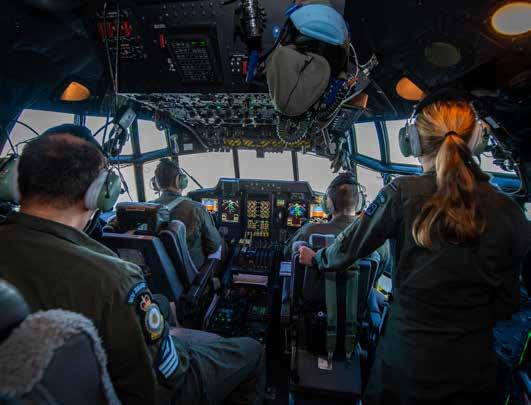
“The first flight was a high-risk one where they tried to get those with more serious medical conditions on board. We had one passenger who was quite unwell and required some care on the way home. The other flights went more smoothly and health issues were screened by our medic early on so medical requirements were able to be arranged ahead of time.”
The crew helped families with babies, who usually wouldn’t be cleared to fly in a Hercules, she said.
“We needed to make sure they were okay with the altitude changes and helping equalise the pressure on their ears. So we worked with parents to help them make sure their child was as comfortable as possible.”
They also had passengers who were running out of medication because of the unexpected longer stay, MAJ Little said. Flying in and out of the aerodrome meant the crew didn’t see the turmoil happening outside the gates, which made the experience “surreal”.
“The only thing we could see was across the road from the airport was a car yard that had been burned to the ground. That reminded us what was going on outside the secure airfield that we were in.
“We were told to be prepared to encounter some upset and frustrated people because it had taken us so long to get there. But I didn’t come across anyone like that, everyone was so stoked to see us, just so pleased to be getting home – to the point where the passengers would break out in applause when we landed in Auckland. We don’t really get that on a military flight. There were also a lot of hugs for us,” she said.
“The deployment was great because it’s what we train for and to be able to do that and to see how appreciative the people who we were supporting were, it made our job even more worthwhile. That’s what we’re here for.”
“It was probably some of the most exciting flying that I’ve done. I’ve only been at No. 40 Squadron for the last two or three years. Doing something that directly helped people and you could see the impact that had, was quite rewarding.”
– Sergeant Emma Porritt
EDITOR REBECCA QUILLIAM B Y
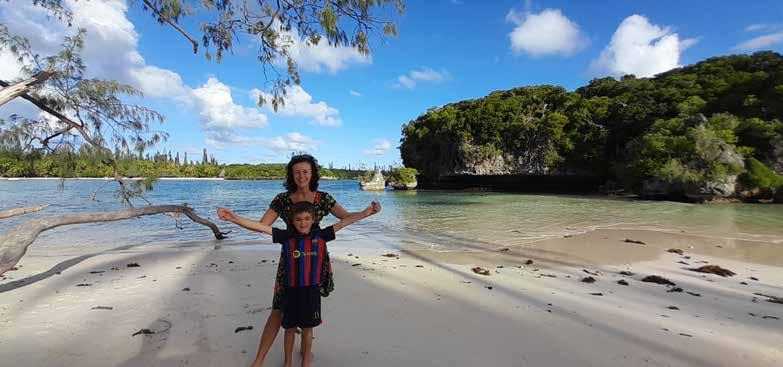
All Sofie Jacobs wanted was to take her sixyear-old son Jack on a beautiful holiday to New Caledonia as a treat. Instead, she found herself caught in the middle of civil unrest on the island that was supposed to be a Pacific paradise.
“New Caledonia was really nice, but it went a bit pearshaped.” Ms Jacobs and Jack were some of the roughly 300 passengers returned to New Zealand from the troubled nation in a C-130 Hercules. Flying home in the aircraft was her son’s favourite part of his holiday, she laughed.
The pair were planning on staying in New Caledonia and surrounding islands from May 3 to 20. But they found themselves stranded when violent protest broke out in the middle of their holiday.
The start of Ms Jacobs and Jack’s visit was ideal with visits to local tourist attractions, but it wasn’t to last.
“Then one day we were going to visit a waterfall and we suddenly saw gendarme (police) vehicles and I wondered if they were training. We drove up a bit further and saw some smoke and then came across a road block with armed gendarmes, who told us to turn around.
“We were told there were just demonstrations, and nothing to be concerned about, but I felt there was something not right.”
On May 12, Mother’s Day, the pair travelled to nearby Isle of Pines, but after arriving they were told all transport back to New Caledonia had stopped and it was unknown when they could leave.
The next day the riots began.
“We had no way to get off the island because the planes and ferries stopped running, the international airport closed and Air NZ started to cancel flights. We heard the Air Force was waiting for the authorisation to land, so for me it was quite stressful around the uncertainty of when we would be able to go home and how bad would the situation get.”
She tried to protect her son from understanding the extent of the situation and was finally able to tell him once they were back in New Zealand.
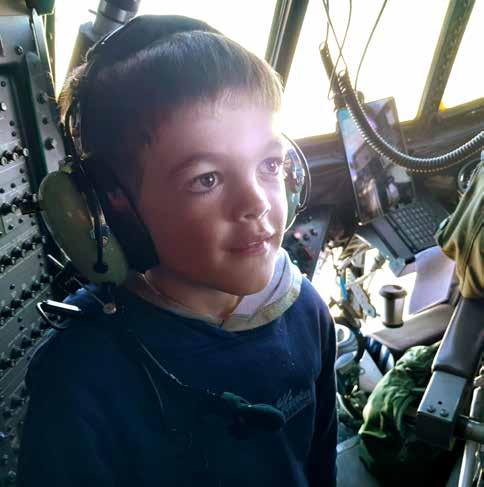
“It was scary though. After a few days the ferry was able to make a special trip out to take us back to Nouméa where we had to stay in a hotel. There were lots of Army vehicles and armed gendarmes around.
“We only had to stay one night and the next day we were put on a bus and straight to the airport and onto the Hercules.”
It was a unique experience and once she knew she and Jack were safe on the aircraft, emotions were able to take hold, Ms Jacobs said.
“When we finally boarded, that’s when I had some tears because for half the holiday I was running on adrenaline and I had to keep myself strong for my son. But I stepped on the plane and I started crying and one of the Air Force crew gave me a hug.”
Aircrew then gave the mother and son a special experience by inviting them up to the cockpit.
“They gave us a headset and we could talk with the pilots. It was the most amazing experience for a little boy,” Ms Jacobs said.
“I could really feel the humanitarian side of the Air Force people and their warmth. I felt we were really looked after once we were on the plane.”
Jack said he had never been on a military aircraft and the flight was “really cool”.
“My favourite part was going in the cockpit. They put headphones on me so I could talk to the pilots. They said they once carried a crocodile and once they carried an elephant.
“The plane was really noisy. It didn’t look that cool from the inside, but it did look cool from the outside. It didn’t have proper seats. They gave me two badges, but I lost one.”
Jack explained he was joined by another special passenger named Crabby.
“He comes from Nouméa aquarium and he’s red and my toy. Crabby thought the flight was quite fun too.”
The crew said they had a great time flying home Jack and his mum and they promised to replace the lost badge.

“Just to see people there who were experienced and I knew they would get us out of there – it was a very special experience. I’ve never had to be rescued before.”
– Sofie Jacobs
The Defence Force’s Military Working Dog handlers are breaking new ground in using a special canine mannequin to practise administering first aid to an injured animal.
Fourteen handlers, combat medics and kennel staff have undergone the introduction into service of the mannequin.
The star of the training, held recently at Linton Military Camp, was the realisticlooking K9 Hero mannequin – built to resemble the Belgian Malinois breedthat can bark, whimper and bleed at the press of a button.
The Defence Force is the only working dog organisation in New Zealand that uses this type of equipment as part of emergency first aid training.
Air Force and NZ Army personnel were trained using scenarios they may encounter – such as military working dogs suffering shotgun wounds.
Defence Force Military Working Dog Capability manager Alan Inkpen said personnel were taught how to triage and stabilise an injured dog.
“We’re not expecting handlers to become veterinarians, but rather have the required skills to help them keep their four-legged colleague alive so that it can be transferred out to receive specialised care.”
The K9 Hero mannequin is made by Tauranga-based emergency training product maker PracMed NZ.
Managing Director Simon Carkeek said the mannequin allowed handlers to practise packing wounds, check for a pulse, airway management, intubation, breathing response and CPR.
“Combined with flexible joints, bag ventilators which cause the chest to rise and fall, bleeding wounds and other features, dog handlers and medics can respond to medical situations,” he said.
The K9 Hero is operated by a hand-held controller that monitors in real-time the effectiveness of treatment of things such as pulse rate, strength and bleeding.
Air Force Military Working Dog handler Aircraftman William Middleton said the course was designed to reinforce existing medical skills as well as learning how to manage training scenarios so they can train others.
NZ Army Sapper Rigel Blanchet, an explosive detective dog handler based at Linton, said the K9 Hero mannequin brings a sense of realism to medical training which is crucial for preparing a handler for a real life scenario.
“This is my first introduction to canine trauma training and my first time using this type of mannequin. Being able to physically insert a needle into a mannequin’s vein and set up an intravenous line is very different from just learning the theory of how to do it.
“Being able to help your dog when it’s in distress is vital – and having the knowledge to provide first aid and stabilise your canine teammate may mean the difference between life and death.”

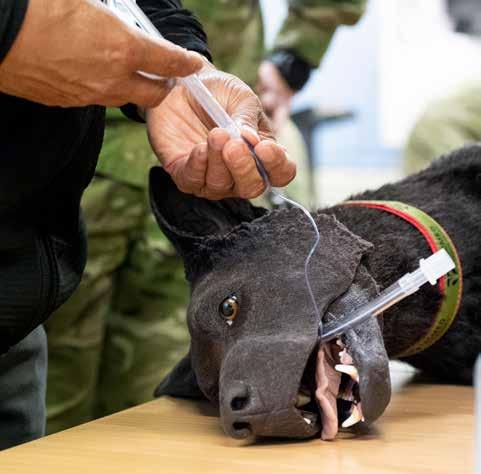
“In the Air Force, the primary focuses of our patrol dogs are base and asset protection and security. The training that we’re receiving is highly beneficial to us because in that security role we could come across threats that not only harm us but our dogs.”
– Aircraftman William Middleton
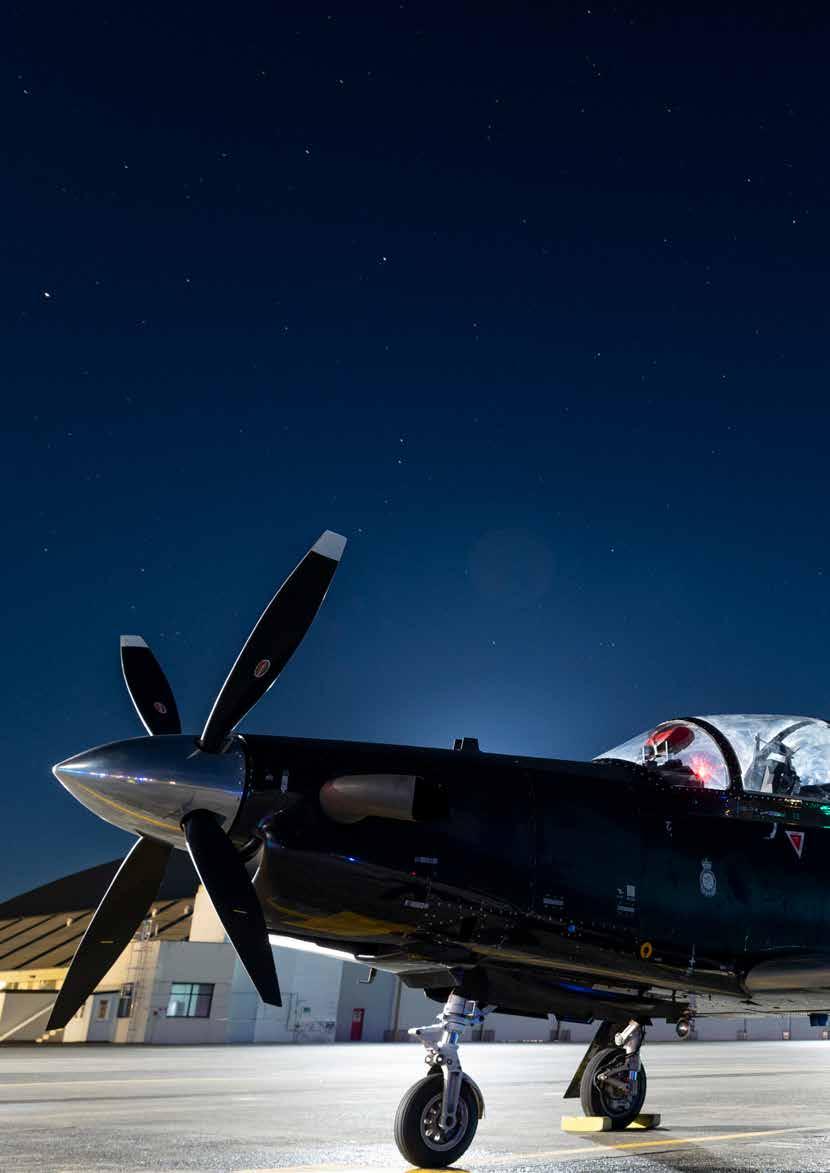
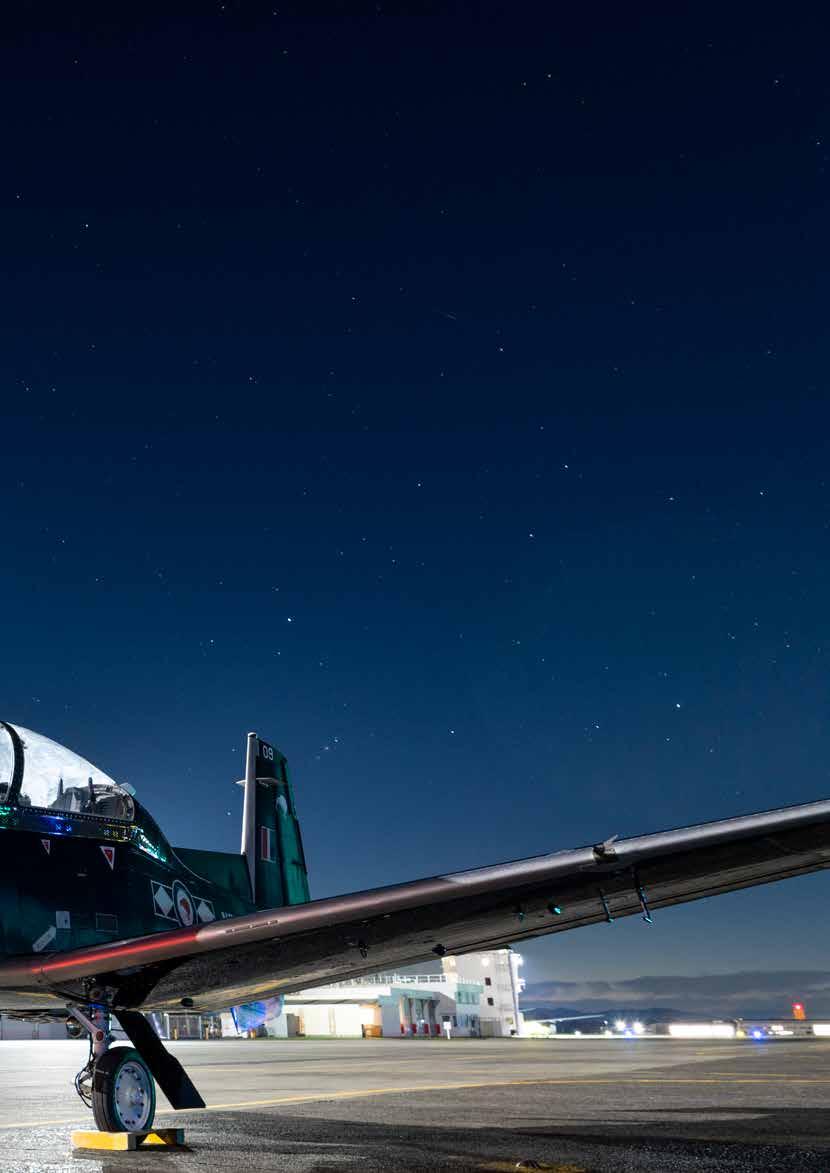
Per ardua ad astra – through adversity to the stars. The Air Force’s motto strikes a deeper meaning during Māori New Year, Matariki. Rituals of past generations are celebrated and new traditions for the next generations are created. Air Force News listens to stories of past and present Matariki celebrations.

Matua Hemi Te Peeti, Ngāti Raukawa ki te Tonga, is the Air Force’s new kaumātua and brings a wealth of knowledge and experience to the role.
“I was part of the kaumātua for the Army as well, so it’s a role I’m accustomed to. I’m hoping to help with the cultural aspects relating to tikanga and kawa (Māori protocol and etiquette). I’d like to help with some programmes on a bicultural level, in terms of representing te tiriti the best way I can, and supporting wherever I can.”
Matua Hemi says there is a connection between the Air Force and Matariki in the way the Matariki constellation works with the wider context of the universe.
“Matariki is only one part of a whole constellation family. For Matariki to be able to represent itself for what it is today for Māori people, it takes the wider view to create the importance of the stance within the stars.
“I think it’s a bit like the Air Force, it requires the different branches of the Air Force to create the main part of that body to work well. Matariki is about unity, togetherness, about memory and believing in people and skills taught. It’s also about how we manage ourselves in terms of the environment we live in and how well we work with it and to look after it in the best way we can.”
This year during Matariki, Matua Hemi will be giving a talk about the history of the celebration.
“So I talk about the whakapapa of the stars, the stories associated with them and the importance of understanding the environment we work and live with.”
He also has his own traditions he shares with his children.
“Matariki for me is all about the environment, so I tell my children if they want to live well in this world, you’ve got to look after what we have.
“I’m looking forward to doing the role in the Air Force and having that ability to share what I know with everyone there. The future looks promising for us all.”
Ground Support Equipment technician Leading Aircraftman (LAC) Kaea Preston, Te Āti Awa, said for her Matariki is a celebration and recognition of the year that’s past and looking forward to the year ahead.
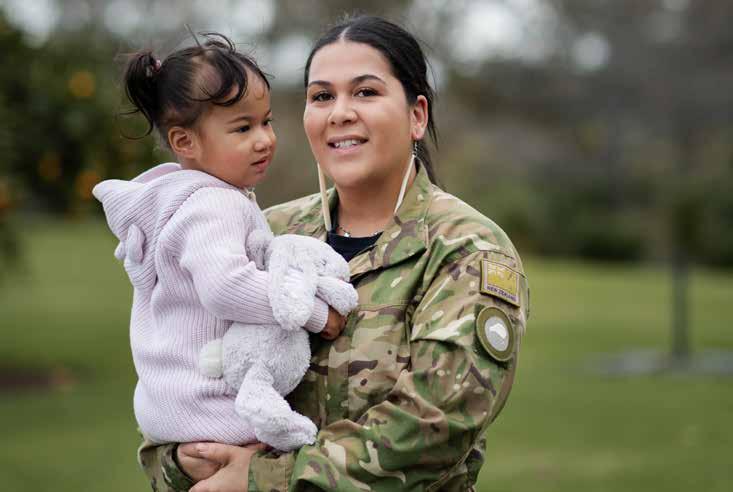
Mother to two-year-old Ahi, LAC Preston said for the past year she is grateful to have been able to watch her daughter thrive.
“I’ve spent more time with my family in the past year so that’s more to do with Matariki, the mother stars and bringing people together. My family includes my friends who are in Auckland.”
She has spent some time learning about Matariki and the traditions it brings.
“This year I will bring to prominence Matariki traditions for my daughter as she grows up. I want to give her all the knowledge that I didn’t have around Matariki and pass it on to her so she can grow up with the more traditional aspects and appreciation for why we look at the stars and what they mean.
“My intention for this Matariki is to try
to give thanks to the stars in regards to cooking kai that shows gratitude to the stars. I’d like to make kai that represents each whetū (star) and as it cooks allow the steam to be our gratitude to the stars for bringing us this kai.”
Each star represents either kai or an aspect of taiao (nature), for example the star Tupuānuku, which represents food that grows within the soil, like potatoes or kūmara, LAC Preston said.
“It’s about being able to get the kai that represents each star and releasing the steam into the sky as a way of giving thanks to them.”
“I value traditions a lot and it’s setting the tone for my child and hopefully she can pass it along to hers.”
– Leading Aircraftman Kaea Preston
WORDS | ANDREW BONALLACK
PHOTOS | CPL MADDY BUTCHER
Sergeant Kirrin Borgman says the thrill of waka ama racing helped her connect with the Samoan side of her family.
By day, Sergeant (SGT) Borgman works at Trentham Military Camp as part of the Defence Force’s Personnel Archives and Medals unit, processing Long Service Awards for Air Force personnel.
When she’s off duty, SGT Borgman celebrates her Samoan language and culture as a member of Ōtaki Waka Hoe, a club involved in racing outrigger canoes.
SGT Borgman, who is of Samoan and Scottish heritage, grew up in Titahi Bay, Porirua.
She said there was a strong Pasifika presence where she lived and at Wellington’s St Mary’s College, where she went to school, but as a teenager she had a bit of an identity crisis.
“I wasn’t really Samoan and I wasn’t really Scottish and not really feeling like a New Zealander either.
“I played the bagpipes and was involved in pipe bands and Scottish events from a young age so I felt more comfortable with that side. I still have my bagpipes and get them out on special occasions.”
She joined the Air Force in 1999: “My mum thought it would be a good idea!”
While on a posting to Singapore with her husband, who was also serving in the Air Force at that time, they got involved in waka ama.
“Because we were the new Kiwis someone came and asked, ‘Do you paddle?’ I had only done dragon boating before. We had one week training and then we were racing.

“I soon learned how to paddle a single person va’a and bought my own when my grandmother, Momotu, passed away in 2020. I named it ‘Feso’otaiga o Motu’, which translates to ‘Connector of Islands’.
“So now my va’a connects me to Singapore, New Zealand, Samoa, my grandmother and daughter Arya Momotu.”
SGT Borgman has accepted she comes from both cultures and doesn’t have to know everything about them in order to keep them present in her life.
“Seeing how my family can come together to support each other in good times and in bad makes me proud to be a Samoan. And watching my daughter learn Samoan at school - I’m so happy that she has that opportunity.
“I would describe my people as those who love me and those who I love back.
Plus all of those who are related to me by blood or marriage, or circumstance, even if I’ve never met them.
“I think being from a Samoan background I naturally foster that ‘family’ aspect in my workplace. It made me a little bit shy initially as I tended to step back and not want to show others what I’m capable of.
“My view is that the Defence Force is all one big NZDF ‘aiga (family), and that we should be here to support one another.”
There’s excitement on the horizon for SGT Borgman; her waka ama team of six has qualified go to the IVF Va’a World Club Sprints in Hawaii this year.
“It’s been such a big life journey for me as well as a va’a journey, from novice to attending Worlds.”
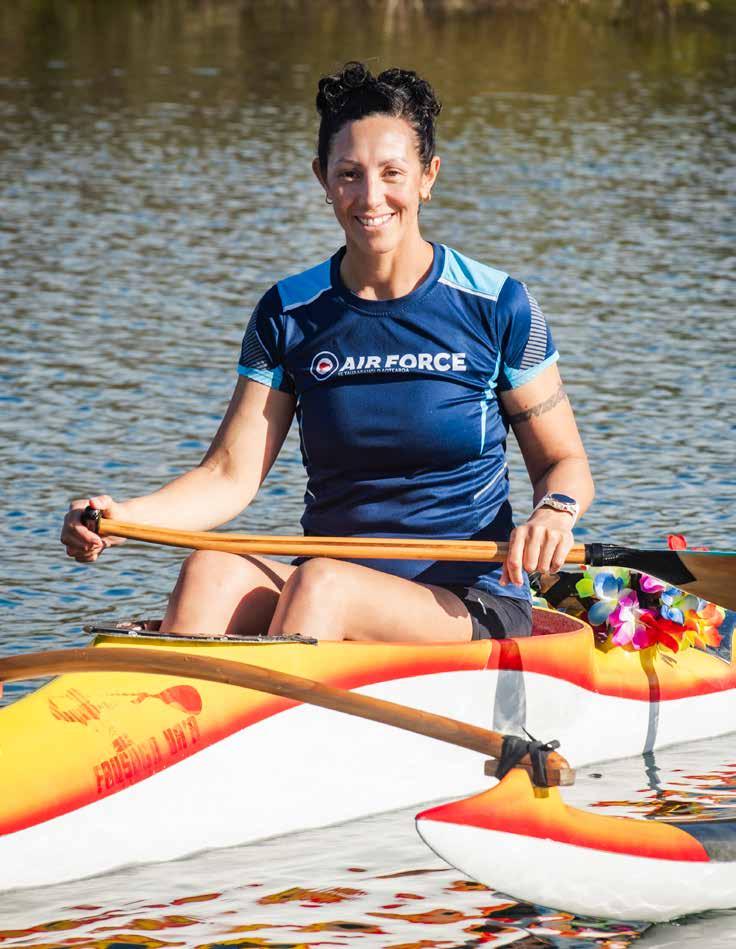
“Once
you race, that adrenaline, that camaraderie, just being on the water, it drew me back. I could remember being in a va’a (outrigger canoe) in Samoa when I was a kid. It felt like I was where I was meant to be.”
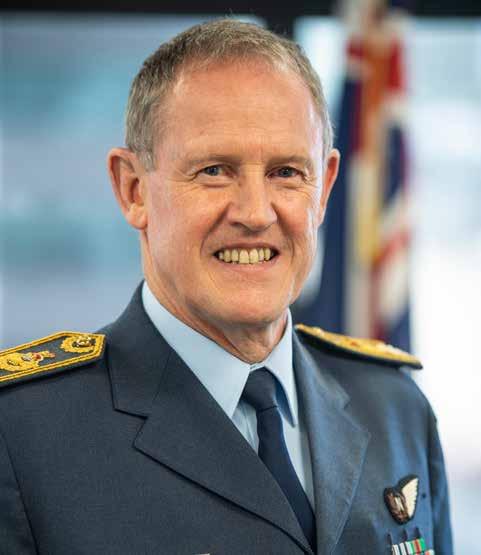
The outgoing head of New Zealand’s military, Air Marshal Kevin Short, says he is “chuffed” to be recognised in this year’s King’s Birthday Honours List after many years of reviewing honours lists featuring names of fellow Defence Force personnel.
Air Marshal (AM) Short has been appointed a Companion of the New Zealand Order of Merit (CNZM) for his nearly 50-year military career in the NZDF, including in his latest role as the Chief of Defence Force (CDF).
The CNZM is one of two recognitions for the Defence Force in this King’s Birthday Honours list, with Wing Commander (WGCDR) Mark Whiteside receiving a Distinguished Service Decoration (DSD).
During his tenure as the longest serving CDF in more than 50 years, he led the Defence Force through significant and unprecedented domestic and global events, from the Whakaari/White Island volcanic eruption, the Covid-19 pandemic, to the evacuation of New Zealanders from Kabul during the 2021 Taliban takeover of Afghanistan.
AM Short said after years of reviewing honours lists featuring names of Defence Force personnel, it felt surreal to see his own name amongst the list of recipients.
“I wasn’t expecting it and I was totally caught out. I feel really honoured and quite chuffed about it. I’ve spent all of my adult life dedicated to the Defence Force so it means a lot to receive this level of recognition.”
AM Short’s citation also acknowledged his work in a resource-constrained, pandemic environment, managing complex capability updates, overseeing military and humanitarian aid operations in New Zealand and overseas and leading important initiatives in leadership and diversity.

“I will wear the CNZM on behalf of everyone who serves in the Defence Force. I see this as an acknowledgement of not only my effort and dedication to service, but also that of everyone I have had the privilege of leading and working alongside.”
– Air Marshal Kevin Short
The New Zealand Distinguished Service Decoration has been awarded to WGCDR Whiteside for services to the Defence Force for his work in introducing the P-8A Poseidon maritime patrol aircraft into service with the Air Force.
WGCDR Whiteside was posted to the Poseidon project team in early 2019 and became a leading figure in acquisition and delivery of the fleet, where the four aircraft were introduced into service last year. His approach allowed a seamless transition from the old P-3K2 Orion to the Poseidon, and he then led the move of No. 5 Squadron from Base Auckland to Base Ohakea.
“His leadership enabled the new unit to establish a positive culture and identity, resulting in successful integration of up to 170 personnel and their families into the Base Ohakea community,” his citation said.
WGCDR Whiteside, who joined the RNZAF in 2001 and trained as an Air Warfare Officer, said he was humbled and honoured to receive the recognition.
“I am mindful that this is an individual honour yet the success of the Poseidon is very much due to the collective effort of a whole team of outstanding people.
“I am very proud of the capability we have delivered for New Zealand and the people behind it who are now realising its potential on operations.”
PHOTOS | CPL SEAN SPIVEY

An
Air Force aviator is raising money for breast cancer awareness by selling Pink Kiwi patches, modelled on the Defence Force’s generic military-issue patch.
Aircraftman (AC) Yolandi Cook, a logistics operator at Base Woodbourne, has created – and is selling - the first ever Pink Kiwi patch, with all profits being donated to Breast Cancer Foundation NZ.
The Air Force is getting behind AC Cook’s initiative by allowing its personnel to wear the Pink Kiwi patch on their uniforms during the week that recently coincided with Pink Ribbon Breakfast Day.
The 29-year-old mother of two has not had breast cancer, but says she’s witnessed loved ones go through the disease. She also had a scare recently, where she’d found a breast lump which thankfully turned out to be benign.
The scare motivated her to come up with a way to spread breast cancer awareness to her colleagues and the public.
“It was quite sobering at this age to think I might have breast cancer. As a mum, I can’t imagine what it’d be like to face the possibility of not seeing your kids grow up – and yet I know this is an experience that is common for Kiwi women.”
So far the Kiwi patches have raised $23,000 for Breast Cancer Foundation NZ.
AC Cook says the bulk of patches have been sold to New Zealand Defence Force personnel, with some members buying multiple patches to swap with their foreign counterparts while on deployment overseas.
“These patches can also be worn by the general public and could be popular on the kids’ schoolbags or with backpackers on their overseas trips,” she said.
Breast Cancer Foundation NZ’s chief executive, Ah-Leen Rayner, says she looking forward to seeing photos of Air Force’s uniforms adorned with the Pink Kiwi patch.
“We love seeing imaginative ways to start important conversations about breast cancer awareness and we’re thrilled the Royal New Zealand Air Force has embraced the pink kiwi,” she said.
Breast cancer is the most common cancer for Kiwi women, with about 3500 women being diagnosed every year.
“Our vision is to see zero deaths from breast cancer and as a charity that doesn’t receive any government funding, it’s only thanks to wonderful fundraisers like Yolandi that we can work towards this ambitious goal.”
She said Pink Ribbon Breakfast is Breast Cancer Foundation NZ’s largest annual fundraiser. where tens of thousands of Kiwis host special events in their homes, workplaces and communities throughout the month of May.
The money raised goes towards the charity’s work in education, research, advocacy and patient support.

“I’m proud to see the patches being worn and to help make a difference. I’m thankful to the Air Force community for encouraging me to support a cause that means a lot to me.”
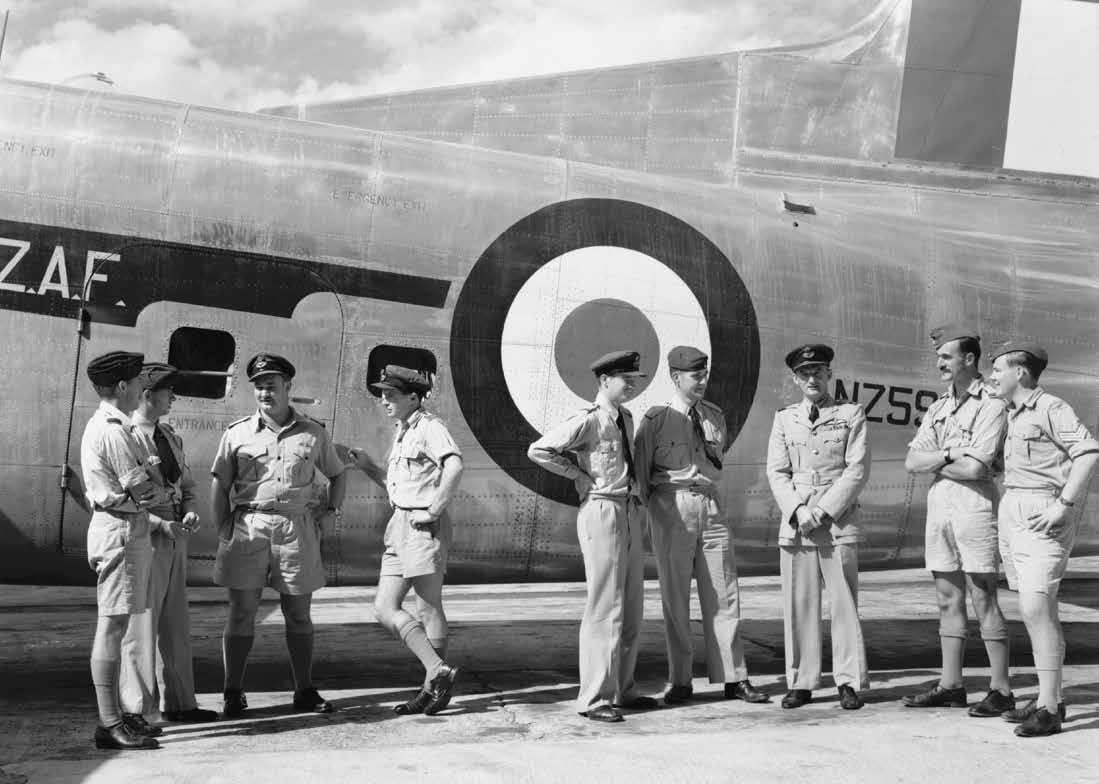
After World War II, the Air Force had a presence in Singapore for more than 40 years, including during the Malayan Emergency from 1948 until 1960. It was during the emergency in 1959 that Kiwi Air Force crews last flew an operational sortie against an enemy.
In the relative peace of the immediate post-World War II years, the world was trying to take a deep breath after the great conflict. In the Malay Peninsula a small group of freedom fighters called the Malayan National Liberation Army (MNLA) were agitating for a free Socialist state. Many of these fighters were veterans of fighting the occupying Japanese forces during the war. The MNLA were fighting for a Socialist Malay state free from British colonial rule, while the British were fighting to defeat communism and protect their economic interest in the area.
The Malayan government declared a State of Emergency in June 1948 and called on the Commonwealth to contribute to the effort. In September 1949 the first Air Force contribution arrived in Singapore. ‘A’ Flight of No. 41 Squadron, with three Dakotas, was attached to the Royal Air Force (RAF) Far East Air Force.
They transported troops and freight and dropped supplies to soldiers in the jungles. They remained there for two years, flying 785,000km around Malaya and as far afield as Sri Lanka, Hong Kong and Japan.
As the conflict continued, the British required increased contributions to their Strategic Reserve, so in 1955 No. 14 Squadron was moved from Cyprus to Singapore to fly leased-RAF de Havilland Venom jet fighters, and No. 41 Squadron moved from New Zealand to Singapore, flying Bristol Freighter transport aircraft. No. 41 Squadron was based at RAF Changi, on the other side of the island from No. 14 Squadron’s base at Tengah. They operated courier flights, dropped supplies to soldiers in the jungle, and supported training exercises. Their Bristol Freighters were well suited to the work and, when dropping supplies over the jungle, two British Army dispatchers were included in the crew. The work was demanding and exacting over the rugged landscape.


The squadron lost one aircraft when it flew into a mountain in thick cloud in the Cameron Highlands, killing all but one on board. It took soldiers two days on foot to reach the wreckage but by then the British soldier who survived had begun walking out. Twelve days later he met up with other soldiers and returned to his unit.
No. 14 Squadron flew Venoms on operations, dropping bombs, firing rockets and strafing targets. “Firedog” operations were pre-planned strikes, while “Smash Hit” operations were in response to sudden calls from soldiers who had been ambushed. Although the worst of the Emergency was finished by the time they arrived in 1955, No. 14 Squadron proved its worth in support of the Commonwealth ground forces.
No. 14 Squadron was withdrawn to New Zealand in May 1958 and the ageing Venoms – the last to be used on operations - were returned to the RAF. The squadron had dropped some 225,000 kilograms of bombs and fired over 1500 rockets at enemy targets.

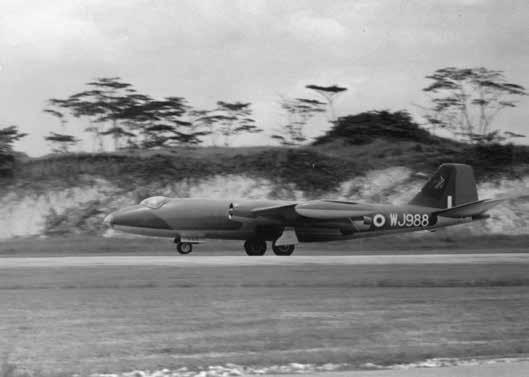
No. 75 Squadron replaced No. 14 Squadron, and flew leased RAF English Electric Canberra light bombers. They arrived in Singapore in July 1958 after flying their aircraft all the way from England, and took over the buildings and facilities previously used by No. 14 Squadron. Even though the Emergency was in the final period, the squadron exercised regularly with the British, Australian and US Air Forces.
Both 14 and 75 Squadrons proudly displayed their New Zealand pride on their aircraft; No. 14 Squadron painted a white kiwi on the black rudder of their Venoms and No. 75 Squadron had either a tiki or a kiwi over a map of New Zealand on their Canberra fins.
The last offensive airstrike on Communist forces in Malaya occurred on August 17 1959 at Bukit Tapah in Perak and involved Canberras of the RAF, Royal Australian Air Force and No. 75 Squadron RNZAF. This is the last time Air Force bombers flew an operational mission against an enemy.
The Malayan Emergency was declared over in July 1960, 12 years after it began. However, tensions in the area remained and the Air Force retained a presence in Singapore and South-East Asia until 1989.
LEFT RNZAF personnel before embarking for Malaya on a No. 41 Squadron Bristol Freighter. RNZAF Station Whenuapai
TOP MIDDLE
British Air dispatch personnel push crates out of a No. 41 Squadron ‘A’ Flight Dakota during a supply drop over Malaya TOP RIGHT
No. 14 Squadron Venoms firing rockets at China Rock, near Singapore, during target practice, 1958
BOTTOM MIDDLE
Loading a bomb onto the port wing of No. 14 Squadron Venom WE481. Believed to be RAF Station Tengah BOTTOM RIGHT
No. 75 Squadron Canberra WJ988 landing at RAF Station Tengah after the first bombing strike by the squadron

I recently embarked on HMNZS Te Mana with technicians from No. 6 Squadron for a fivemonth deployment. I put my hand up for this opportunity, even though like most other aircraft technicians this was not where I saw my career going when I joined the Air Force.
Life on ship is what you make of it. On a normal day at sea we will have an idea of when the aircraft is planning to fly, but flying can start at any time.
To start the evolution there will be a broadcast over the ship’s speaker system called “Pipes” with the command “prepare for flying”. That means our team of eight technicians and three aircrew have 60 minutes to get the aircraft in the air.
This involves moving the aircraft out of the hangar onto the flight deck, spreading the blades, refuelling and setting up all the required safety equipment in case of an emergency. Once the aircraft is started up we pull the pins, chocks and tie down chains, then kick the tyres and light the fires and the aircraft is on its way.
While the aircraft is flying we are on standby for anything that might be required. Anything happening on the flight deck is our responsibility, whether it is a rotors running refuel, weapon load, hooking up an underslung load or winching someone into the aircraft.
When the aircraft lands we fold the blades and drag it inside the hangar, carry out post-flight servicings and fix any faults before the next day’s flying.
Flight deck operations are additional to the normal duties of a technician in the Air Force and fairly unique to No. 6 Squadron so it was also a great opportunity for me to upskill and develop techniques for things like my resilience, leadership skills and my ability to work under pressure.
I have also been involved with some larger tasks such as removing blades or replacing gearboxes, which comes with its added challenges rocking and rolling on the open ocean. We do not have the luxuries of our hangar in Whenuapai and have limited equipment, meaning we have to use Kiwi ingenuity and think outside the box to get things done.
During the deployment we spent lots of time around Australia with a few stops in Sydney before heading north.
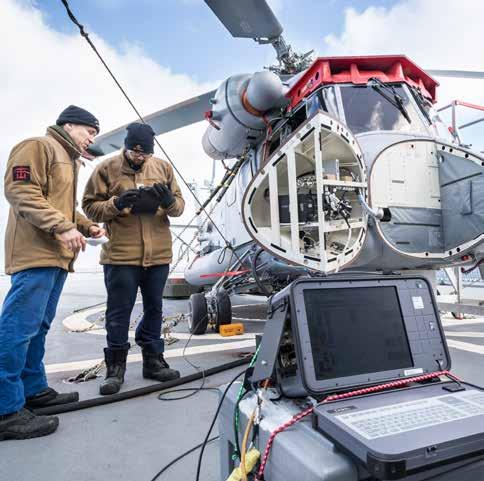
Between some great times spent in ports exploring Vietnam, Malaysia and Singapore we participated in Exercise Bersama Lima, engaging with other nations to cement the training we had conducted over the previous months. During the exercise there was a day of respite where personnel from each ship were dropped off on a Malaysian island. We held a beach sports tournament ending with cultural performances and a meal to suit.
This was a great opportunity to socialise, learn about new cultures and see how we are from extremely different backgrounds, but have come together to learn from each other and develop new skills to protect our nations and the region.
Over a five-month deployment on a ship we got to know each other quite well, especially our small maintenance team. Working, socialising and then living together in a small space can be uncomfortable to begin with. If everyone is considerate and respectful there is nothing to worry about.
Over the deployment we learned how each individual operates, where their limits were and formed a close team that could rely on each other with an immense level of trust that I haven’t found in any other team yet.
Integrating with the Royal New Zealand Navy is essential, we are a very small representation of the Air Force, but it is key to building relationships between the services.
Everyone is there for the same reasons, serve our country and go on an adventure. It is also a great feeling when you realise how much of a capability you are contributing to the ship, the Navy and the Defence Force as part of the larger organisation putting into practice years of training to work together achieving our objectives.

“Working on a ship requires a flexible mind-set as the plan for the day always changes and even though there are long days, sometimes in harsh conditions, it always feels worth it in the end.”
Flight Sergeant PCP Davies and Sergeant Brendon Davies are believed to be the first father and son duo to hold Gold Badges in the same predominant sport, basketball, while currently serving. Sergeant Davies recently received his badge and his father was given the honour of presenting it to him.

FLIGHT SERGEANT PCP DAVIES
“Basketball has been a big part of both of our lives. Even from when Brendon and his sisters were little they used to come to games with me in carry cots.”
Flight Sergeant (F/S) Davies’ love of sport began in school. He made representative teams in basketball and rugby and needed to make a choice about which sport to continue.
“I realised that it didn’t matter what the weather was, I could always play basketball, but the weather would often affect rugby games. So I flagged the rugby and played basketball from there on.”
Carrying the sport on in his Air Force career, F/S Davies was chosen for the Air Force men’s team in 1977. He played in the team until he was 52, stopping about 13 years ago, only hitting the court again this year with his son at the inter-base competition for the “old-timers” team.
“Playing at the inter-base competition this year, seeing the old faces and being introduced to the younger players was fantastic and it was great to be around the basketball fraternity again.
“Even off the court, despite fiercely competing in games, there is always great camaraderie between everyone when the games finish.”
He was able to encourage his three children playing basketball by taking on the coaching role with them as they grew up.
“It was a lot of fun being involved all the way. Obviously you’ve got to have an understanding wife because with three kids all playing, I was at the stadium most nights for practices, secondary school competitions and then away for the weekends coaching their representative competition games. Not to mention my own playing, coaching and committee involvement during that same period.”
All that involvement reaped rewards for the father and son. At this year’s Air Force Sports Awards F/S Davies asked the RNZAF Sports Committee if he could present the Gold Badge to his son.
“I appreciate the Group Captain would normally do that, but under the circumstances and the longevity that I’ve had in the services sporting arena, they saw that as a unique opportunity and it was no problem at all. It was a special moment. It definitely surpassed my previous ‘father and son’ highlight of us both playing in the Air Force men’s and NZDF men’s basketball teams in 2006.”

Sergeant (SGT) Davies not only followed his dad’s footsteps on the basketball court, but also in joining the same trade in the Air Force as an aircraft technician when he joined in 2005.
Playing for Air Force basketball teams meant playing with pride, he said.
“There’s an intensity and camaraderie greater than playing in the local leagues. I feel that when I’m playing against the NZ Army and Royal New Zealand Navy, which you can’t explain to others.
“You have to be in that competition to appreciate how you go ‘all out’ for your service.”
Alongside their basketball gold badges, they have also received them for squashSGT Davies - and water polo - F/S Davies.
“Dad coached me a lot through my junior years and through high school. Before I joined the Air Force, I progressed to play in the NZ U18 Development squad and also secured a basketball scholarship for my senior year of high school in Kansas USA.
“It was fantastic to be selected for the Air Force and NZDF men’s basketball teams playing alongside Dad, I believe that was a first father and son achievement at the time as well.”

SGT Davies has two sons of his own, but they may not carry on the mantle of the two older generations.
“My eldest is a sprinter in athletics and good footballer. My youngest is five, so he’s just finding his feet trying everything – but he may still end up on the squash or basketball court.”
Whilst injury shortened my basketball playing days, my wife’s passion for squash convinced me to start playing, which has prolonged my Air Force sporting career.
Being presented the Gold Badge by his father was a highlight of SGT Davies’ sporting career, he said.
“I believe we are the first father and son with Gold Badges serving at the same time. It’s quite a privilege and an honour to be awarded my Gold Badge and to join an elite group of Air Force sports men and women, and to have it at the same time as dad is pretty special.”
“It was fantastic to be selected for the Air Force and NZDF men’s basketball teams playing alongside Dad, I believe that was a first father and son achievement at the time as well.”
– Sergeant Brendon Davies

Personnel from the Pacific Air Forces Safety Directorate co-hosted the annual Indo-Pacific Safety Air Forces Exchange alongside their counterparts from the Royal New Zealand Air Force in Auckland recently.
Known colloquially as ISAFE, the exchange focussed on bringing allied and partner countries together to enhance flight safety throughout the Indo-Pacific through discussions on safety best practices, lessons learned, and cooperation between nations.
This year, ISAFE saw attendance from Australia, Brunei, Indonesia, Japan, Maldives, Mongolia, Netherlands, Nepal, Papua New Guinea, Philippines, Singapore, South Korea, Sri Lanka, Thailand, and the United Kingdom.
Echoing the remarks made by Base Auckland Base Commander Group Captain Mike Cannon, US Air Force Colonel (COL) Brent Harms, Pacific Air Forces (PACAF) Safety director, provided his opening remarks explaining safety isn’t a one person or one time job, but something everyone must be continuously vigilant about.
“Our jobs as safety professionals demand our attention to enable a just culture where everyone is empowered to be risk aware of their mission and tasks,” said COL Harms. “We must be diligent as subject matter experts in our trade as aviators and also risk managers to operationalise safety and advise leaders for informed decisions to protect life and resources.”
During the event, there were discussions on various safety topics that included Safety Management System, Proactive Safety, Mishap Prevention, Bird/Wildlife Aircraft Strike Hazard mitigation, Human Factors issues, and Risk Management.
The conversations held during ISAFE events help build better safety programmes to protect people, who are the driving factor of each and every country.
Director of Operating Airworthiness
Wing Commander Rachel James said as aviators, it was imperative to stay informed about safety, embedding it into everything the Air Force does.
“The ISAFE conference provided a great opportunity for us to get alongside other safety minded individuals from partner Air Forces, to hear about new safety initiatives, share our own experiences, and challenge our thinking about how we do safety.
“Aviation safety is what we do, because it is the best way and the right way to deliver outputs,” she said.
“Working collaboratively with our partners from across the Indo-Pacific region is important, as it provides us with an opportunity to critically review our own aviation safety programme, in light of what other militaries are doing.”
For the Indo-Pacific Region specifically, ISAFE also enables Agile Combat Employment (ACE) by allowing crosstalk between countries, which enhances planning for future exercises and operations.
“The success of ACE hinges on safety; an element built on trust and the understanding of how far all parties are willing to accept or mitigate risks,” said PACAF Aviation Safety deputy chief Lt. Col Joshua Ramirez. “Common safety practices allow for more force projection while keeping teammates safe throughout the fight. ISAFE helps ensure that there is an eye on safe operations at all ACE locations.”
ISAFE is all about sharing best ideas and practices so each nation can bring those ideas back to their countries to enhance their own safety programmes. The next iteration for 2025 is currently slated to be in Guam.
A reunion for past and current serving Communications staff is to be held in Palmerston North and Base Ohakea on September 25 and 26, 2024.
Those of you who served pre-2003 in the former RNZAF Telecommunications Branch trade musterings of Telephone Operator, Comm Asst, Teleg, COM OPR/ TC/STC OPR, or post-2003 as CISMECH or CISTECH in the Communication and Information Systems (CIS) trade are invited to request event and registration information.
Send an email to Q85988@gmail.com with ‘Please send me Information’ in the subject line.
RNZAF Base Ohakea, July 19–24, 2024
Friday
• Registration
• AGM
• Meet and greet
Saturday
• Tours of No. 3 Squadron and Biggin Hill
• Drinks and dinner
Sunday
• Overflow tours
October 18-20, 2024
Celebrating the history of the squadron from:
• 75 (Home) RFC, 1916-1919
• 75 (Bomber) RAF, 1937-1940
• 75 (NZ) RAF, 1940-1945
• 75 (RNZAF), 1946-2001
The itinerary includes a weekend at Classic Flyers in Tauranga.
For more information, email the secretary: reunions@75squadron-raf-rnzaf.com.
• Special first home loans to get into your first home faster
• Refinance, borrow to upsize or renovate
• Take out a term deposit with as little as $500
• Lend in retirement
• Personal loans and every day banking
Check out the Defence Loans and Banking package through the Police Credit Union scan; the QR code or go to policecu.org.nz/nzdf-pcu/

Before their graduation, the 222 Wings Course students came out to the threshold for an early morning course photo. Everyone was looking their best, but Texan #10 was looking especially spectacular in the sunlight, and deserved a quick solo snap.




Whether you like painting, sculpting, photography or are someone who has always wanted to give art a try, we encourage all skill levels to take part. It is open to any current serving or ex-serving NZDF injured, wounded or ill personnel, their family and friends and Families of the Fallen.
Submissions Close: 9 August 2024
Selected artworks will go on display in the Pumanawa Art Gallery in Christchurch from 1–6 October 2024.
To register or for more information, please email artinrecovery@nzdf.mil.nz.